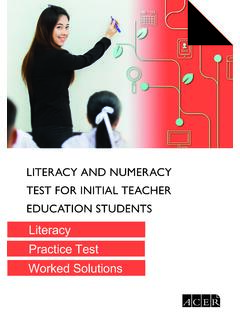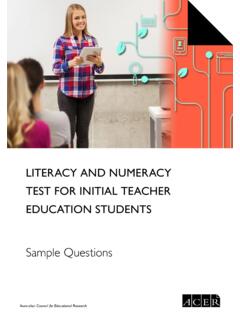Transcription of Assessment framework - Literacy and Numeracy Test for ...
1 Literacy AND Numeracy . TEST FOR INITIAL teacher . education STUDENTS. Assessment framework Department of education and Training TABLE OF CONTENTS. Introduction ..6. Overview ..6. Background ..6. The Australian Core Skills framework ..7. The Programme for International Assessment of Adult Competencies ..7. Literacy framework ..9. Definition of Literacy ..9. Balance between reading and technical skills of writing ..10. Reading ..10. Text medium ..10. Text format ..11. Text Text length and number of Topics ..13. Complexity ..13. Reading Processes ..14. Technical skills of Content ..17. Stimulus and Numeracy Definition of Numeracy ..20. Numeracy content ..21. Numeracy processes ..22. Use of calculators and other mathematical Level of difficulty of the Test's Literacy and Numeracy items ..25. Establishing the target difficulty range of the test items ..25. Defining standards of personal Literacy and Numeracy for new Range of difficulty of test items ..27. Literacy and Numeracy test item contexts.
2 28. Test design ..31. Assessment design considerations ..31. Number of tests and items ..31. Response formats ..31. Reporting ..32. References ..33. Appendix 1 ..35. Literacy Sample Questions ..35. Appendix 2 ..47. Numeracy Sample Questions ..47. Appendix 3 ..61. Assessing prospective teachers' personal Numeracy and Literacy an international England ..61. USA ..61. Chile ..63. Other national approaches ..63. 2. List of Tables Table 1: Target proportions of reading items in each text format category ..11. Table 2: Text type in the ACSF, PIAAC and the Test ..12. Table 3: Target proportions of reading items in each text-type category ..13. Table 4: ACSF definitions of context and text complexity, Levels 2 to 5 ..14. Table 5: Reading processes in PIAAC and PISA ..15. Table 6: Target proportions of reading items in each process category ..17. Table 7: ACSF focus areas for writing ..17. Table 8: The technical skills of writing assessed in the Test and their corresponding ACSF focus Table 9: Target proportions of items in each technical skill of writing category.
3 19. Table 10: Selected relevant topic content by ACSF Numeracy content area ..22. Table 11: Target proportions of Numeracy items in each content category ..22. Table 12: Numeracy processes in the ACSF and PIAAC ..23. Table 13: Target proportions of Numeracy items in each process category ..23. Table 14: Target proportions of items addressing levels of the ACSF ..27. Table 15: Contexts in which Literacy and Numeracy are demonstrated ..28. Table 16: Target proportions of items in each context category for Literacy ..29. Table 17: Target proportions of items in each context category for Numeracy ..29. List of Figures Figure 1: PISA Reading Literacy described scale, by Figure 2: Definition and elaboration of benchmark standards for beginning teachers ..26. 3. PREAMBLE. The Australian Council for Educational Research (ACER) was contracted by the Australian Institute of Teaching and School Leadership (AITSL) to develop the Assessment framework and the pools of Assessment items for the first two years of implementation of an Assessment of aspects of Literacy and Numeracy for students enrolled in initial teacher education courses.
4 The program is known as the Literacy and Numeracy test of initial teacher education students, hereafter referred to as the Test. In order to ensure high quality and fitness for purpose of the assessments, ACER convened an expert advisory group for each of Literacy and Numeracy , consisting of members bringing expertise in Literacy or Numeracy Assessment , or teacher education , or both. One of the main tasks of the expert groups was to advise on the development of the Assessment framework . The Assessment framework document underwent several iterations: first as a discussion paper presented to the initial Literacy and Numeracy expert group meeting in September 2013; then as a version revised in light of the expert groups' discussion to incorporate its recommendations; and subsequently for consideration by a Literacy and Numeracy Steering Committee convened by AITSL, which met in October 2013. The draft Assessment framework that emerged from these reviews underpinned the development of the Assessment instruments for Literacy and Numeracy over the ensuing months.
5 Instrument development was also overseen by the expert groups at regular intervals, and the Assessment items reviewed in light of their adherence to the framework . A field trial of the Literacy and Numeracy items was conducted in universities across Australia in the second half of 2014 and early 2015. This version of the Assessment framework has been revised in light of the results of the field trial and reflects the process of development of the Assessment construct to date. As a work in progress, the framework may undergo further reviews and revisions as the Test program matures. The Assessment framework has been prepared by members of the ACER project team, in consultation with AITSL. ACER and AITSL gratefully acknowledge and thank the expert groups who have contributed to the conceptual development of the Assessment framework . Members of the Literacy expert group Geraldine Castleton, Australian Catholic University Anna Cohen, ACARA. Chris Davison, University of New South Wales Lorraine Rowles, Department of education and Communities, New South Wales Claire Wyatt-Smith, Australian Catholic University, Queensland Members of the Numeracy expert group Peter Aubusson, University of Technology, Sydney, New South Wales Kim Beswick, University of Tasmania Julie Clark, Flinders University, South Australia Pat Drake, Victoria University, Victoria Brian Foster, education consultant, Victoria Peter Sullivan, Monash University, Victoria 4.
6 The framework begins by giving some background and context to the development of a Literacy and Numeracy test for students enrolled in initial teacher education courses. Following this are separate sections on Literacy and Numeracy , outlining content specific to each domain. The body of the framework concludes with notes on aspects of the Test that are common to Literacy and Numeracy . Appendices provide sample Literacy and Numeracy items, and a brief review of comparable Assessment programs from around the world that were reviewed as background to the development of the framework . 5. INTRODUCTION. Overview The Literacy and Numeracy tests for initial teacher education students (hereafter referred to as the Test') aims to assess aspects of the Literacy and Numeracy proficiency of students in initial teacher education programs in Australia, to support the goal that graduates of initial teacher education programs demonstrate Literacy and Numeracy skills as per the National Program Standards.
7 This outcome is associated with an expectation that the personal Literacy and Numeracy skills of students graduating from initial teacher education courses be in the top 30% of the Australian population. The purpose of this Assessment framework is to define the aspects of Literacy and Numeracy relevant to the context of the Test and to provide details of how these aspects of Literacy and Numeracy are measured so that the necessary judgements of student proficiency can be made. It is important to acknowledge that the aspects of Literacy and Numeracy measured in the Test do not span the full range of Literacy and Numeracy capabilities required of practising teachers. The aspects in this framework are those that can be validly measured under the practical constraints of a point-in-time computer-based Assessment delivered to a large number of candidates. One key component of the expert review and iterative development of this Assessment framework was to consider the degree to which the aspects of Literacy and Numeracy included in the framework and consequently the Test can be regarded as core rather than peripheral to the broader personal Literacy and Numeracy of potential Test candidates.
8 For the sake of simplicity, henceforth in this document the terms Literacy and Numeracy are used to refer to the two domains included in the Test. This framework begins with a description of the background to the program. Following this are separate sections on Literacy and Numeracy , outlining content specific to each domain. The framework concludes with notes on aspects of the Test that are common to Literacy and Numeracy . Sample Literacy and Numeracy items are provided in Appendix 1 and, together with information showing how they reflect the framework content. Background In 2011 all education ministers agreed to a national approach to the accreditation of initial teacher education programs. Standards and of the National Program Standards in the Accreditation of Initial teacher education Programs in Australia describe the levels of Literacy and Numeracy required by new teachers: All entrants to initial teacher education will successfully demonstrate their capacity to engage effectively with a rigorous higher education program and to carry out the intellectual demands of teaching itself.
9 To achieve this, it is expected that applicants' levels of personal Literacy and Numeracy should be broadly equivalent to those of the top 30 per cent of the population (our italics); and Providers who select students who do not meet the requirements in above must establish satisfactory additional arrangements to ensure that all students are supported to achieve the required standard before graduation. 6. The Australian Institute for Teaching and School Leadership (AITSL) commissioned the development of an online test to assess the personal Literacy and Numeracy of initial teacher education students prior to graduation. The test assesses whether students meet the level of personal Literacy and Numeracy required by the Accreditation of Initial teacher education Programs in Australia: Standards and Procedures; that is, that all applicants' levels of personal Literacy and Numeracy should be broadly equivalent to those of the top 30 per cent of the adult population.
10 Development of the Assessment began with drafting of the framework , with reference to relevant international and national programs and Assessment literature. Australia is not alone in having an interest in assessing the personal Numeracy and Literacy of prospective teachers. Approaches used in England, the United States and Chile have some parallels with the approach taken in Australia, and there are also some relevant programs and aspects of programs in other countries. Appendix 3. provides a brief survey of teacher -focused Assessment programs being implemented in other countries that provided useful reference points for the development of the Test. Two programs concerned with general adult Literacy and Numeracy in Australia are immediately relevant to the development of the Test: namely, the Australian Core Skills framework (ACSF) and the Programme for International Assessment of Adult Competencies (PIAAC). Both were drawn on extensively to underpin the concepts and constructs to be assessed by the Test.















